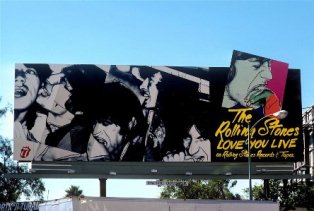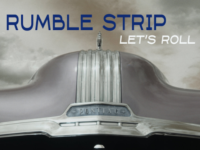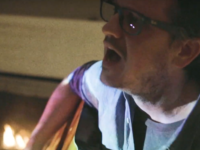There’s something happening here …
What it is clearly isn’t Burma-Shave, and it isn’t Wayne Newton at the Hollywood Bowl or Jerry Lewis in Las Vegas. And it’s not — even though the first billboards appeared on the heels of the Sunset Strip curfew protests (the subject of Buffalo Springfield’s “For What It’s Worth”) — the skirmishes of ’66. The only conceivable “battle lines being drawn” in the 1.7 mile stretch of Los Angeles’ mythic Sunset Boulevard could, in effect, be found in the riot of colors and creativity that went into “young people speaking their minds” via the larger-than-life, hand-painted Rock ‘n’ Roll Billboards of the Sunset Strip, the massive signs that featured such artists as the Beatles—as a group and solo—Pink Floyd, Joni Mitchell, Eagles, ELO, Led Zeppelin, Randy Newman, CSN&Y, Rod Stewart, Linda Ronstadt, Carpenters, the Who, and many, many more.
Created by author/photographer Robert Landau, this coffee table tome of pictorial sumptuousness and textual breadth –the musical, historical, pop cultural, and social contexts and concerns are all well considered — spotlights a golden era, from the late ‘60s to the early ‘80s, of promotional feasts for the eyes. I know that, as a San Fernando Valley teen immersing myself in all things rock during the 1970s, going “over the hill” to attend live performances at various clubs like the Whiskey a Go Go, the Roxy, and the Rainbow Club; or to satisfy a record-buying itch with a spree at the vinyl resting place Tower Records; also held the always-welcome fringe benefit of a truly scenic drive to take in the towering billboards of the ad-adorned boulevard.
Though Landau launches into the heart of the rock ‘n’ roll matter right away in his otherwise chronological recounting, he soon enough devotes a chapter to a sepia-tinged historical overview of “Hollywood’s playground” for tinsel town stars “ever ready for their big close-up.” He descriptively takes us from the advent of the first studios in 1911 through the razzle-dazzle of the clubs and restaurants shoehorned in along the Strip in the 1920s, 1930s, and 1940s, establishments such as the Café Trocadero and Ciro’s. He notes a decline in the 1950s due to the rise of television and the glitz of Las Vegas, just a few hours drive away, which ironically spurred use of Sunset Strip billboards to promote airline travel to and from the City of Angels and Sin City, and to publicize casino headliners such as Sinatra and Sammy at the Sahara and such.
Once the “onslaught of rock ‘n’ roll” and a youthful resurgence bolsters the music scene in the 1960s, however, a reflective cultural and societal shift gives sway to the counterculture, the sexual revolution, political protest, and drug experimentation. In alliance with this zeitgeist-y transformation several clubs, like Gazzarri’s and the Trip, emerge or change their tune — by 1966, Ciro’s reopens with the Byrds taking wing, as the Whiskey spotlights the Doors as the house band — shaking up nearly everyone and everything, including approaches to album artwork and big-ass outdoor advertising on the Sunset Strip.
To a certain extent though, profit-pumping PR and record sales weren’t as important as feeding egos in the star-making machinery and simply pleasing the label’s artists and their hangers-on and families (being able to point to a ginormous, ego-stroking billboard was kind of like reaching “cover of the Rolling Stone” status). This stance, and the sheer audaciousness of billboard aggrandizement, was certainly part and parcel of the aspirational outlook of smaller, independent labels ready to take chances. Good timing and an adventurous “make it up as you go along” spirit saw the first rock ‘n’ roll billboard break on through from New York-based Elektra Records when its head, Jac Holzman, opened a Los Angeles branch at the same time he was considering a shift from folk to rock. Looking out from his West Hollywood office, he was struck by all the billboards being unwisely used — in an entertainment capital so bound-up in passing cars and media — to promote everything but records. Ever mindful of innovative tactics that would set him apart from the competition, Holzman, figuring he had the perfect album with which to balance the scales a bit, launched the eponymous Doors debut with a looming and buzz-breeding billboard, a jumbo screen group portrait of sorts borrowed from the back-of-the-album photo, in an occasion so momentous that the members of the Doors got into the act by climbing up the scaffolding for some Kodak moments. You know they couldn’t get much higher!
Or much more attention-grabbing. With the doors wide open, Elektra combed through their new release schedule to create striking billboards for such Lizard King labelmates as Love, Tim Buckley, and Clear Light. With that unflinching indie outfit having tested the waters, and not drowning, the bigger record companies — A&M, Warner Bros., Motown, Capitol, MCA, Atlantic, Columbia, to mention a few — get into the act with not only the aforementioned artists, but also: David Bowie, Marvin Gaye, Elvis Costello, Gordon Lightfoot, Rickie Lee Jones, Kiss, Free, Village People, Queen, Bee Gees, Cher, Donna Summer, Bruce Springsteen, Eric Clapton, Santana, the Band, the Knack, and many others, all aptly represented throughout the pages of Rock ‘n’ Roll Billboards — and most notably and generously showcased in a chunky gallery toward the end of the book. A few of my billboarded favorites include Nil Lofgren’s self-titled ’75 album, which reeks of colorful carny atmosphere; Curtis Mayfield’s There’s No Place Like America Today (also 1975), with its pictorially pointed commentary incorporating ’40s and ’50s Madison Avenue imagery that juxtaposes white and black social experience; and of course the Beatles’ Abbey Road (1969), simply taken from the classic cover—why mess with perfection? — both before and after Paul is beheaded by souvenir-seeking vandals (the billboard’s designer decided to keep Paul headless during all the “Paul is dead” to-do).
The show and tell doesn’t end with depictions and descriptions, of course. In addition to a seamlessly embedded chronicle of musical transitions and trends — from psychedelia to singer-songwriters, art rock to new wave and punk — as reflected in the graphic style of the billboards, some detours include discussions on the problematic nature of transforming square-shaped album images to a horizontal format suitable for framing in outdoor ads. Matters were helped considerably when the advent of such new designs as the fold-out gateway album cover lent more fitting graphic ground for transferance to a billboard. What also aided the billboard designers and painters were such standbys as plywood extensions that allowed illustrations to extend beyond the borders of the billboard, and newer innovations such as three-dimensional designs, moving parts, and sequential campaigns in which a billboard was altered during the course of its posting (the de-constructing of Pink Floyd’s The Wall is a prime example).
Moreover, special focus is also put on the highly trained commercial artists, designers, and industry movers and shakers — from Norman Seeff and Kosh to Lou Adler — who make sure the “spectaculars” get done right, whether it’s with traditional restraint or the latest bells and whistles. The profile of art designer John Van Hamersveld and “The Making of Exile on Main Street” is especially indicative of the consideration and complexity that can go into the making of a billboard—all the while adhering to a clutter-free industry standard regarding image and expression: “Be brief. Be clear. Be seen.” It’s a mantra uppermost in the minds of the master craftsmen and painters who do the actual hand painting in the hangar-sized billboard studios — in Los Angeles two companies, Foster and Kleiser and Pacific Outdoor Advertising, have a lock on the business — as is recounted in a fascinating chapter devoted to the individualistic technique and practice that went into painting such gargantuan and photo-realistic billboards. Twenty-first century technological uniformity, however, with its reliance on digital printing and electronic transmission, has meant that to “those who treasure the concept of one-of-a-kind, the days of the hand-painted billboard and the artists who created them, are relegated to a chapter of billboard history.”
Fortunately, courtesy of Robert Landau and Rock ‘n’ Roll Billboards of the Sunset Strip, we have some illuminating and evocative new chapters to turn to, with which to stoke some lingering memories.
[amazon_enhanced asin=”1883318394″ container=”” container_class=”” price=”All” background_color=”FFFFFF” link_color=”000000″ text_color=”0000FF” /]
- Almost Hits: The Kinks, “Waterloo Sunset” (1967) - February 26, 2013
- Books: Rock ‘n’ Roll Billboards of the Sunset Strip, by Robert Landau (2013) - February 16, 2013
- Pete Townshend, ‘Who I Am: A Memoir’: Books - November 6, 2012




